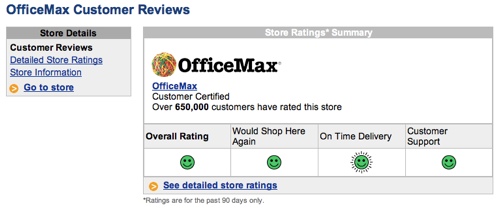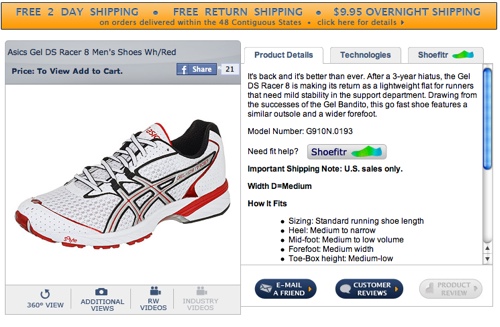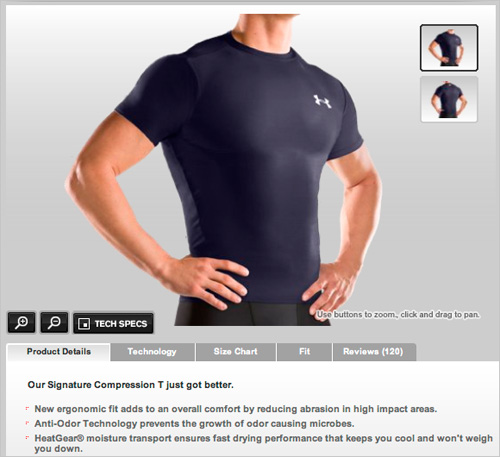E-Commerce Copywriting: The Guide to Selling More
Quality product descriptions can transform e-commerce conversion rates — it’s common to see increases of 30-100%. As well as converting more visitors, search traffic increases drastically when unique copy is written for each product. Most online retailers use manufacturers’ copy or rely solely on images to sell products. They then use inadequate copy elsewhere on their site and fail to achieve a consistent tone to persuade their audience.
Further Reading on SmashingMag:
- Quick Course On Effective Website Copywriting
- 50 Free Resources That Will Improve Your Writing Skills
- Design To Sell: 8 Useful Tips To Help Your Website Convert
- Fundamental Guidelines Of E-Commerce Checkout Design
This creates a compelling opportunity for savvy retailers — by writing quality e-commerce copy you will create a unique competitive advantage.
Essentially, your copy must achieve two goals:
- Establish trust and
- Convince visitors that your product is right for them.
Potential customers cannot see or touch the product since it’s not physically there in front of them. This is why it’s important that your copy anticipates the needs of your visitors while convincing them that your company can be trusted to provide excellent products. Persuasion and creating trust are difficult things to do with words alone; yet, they are still achievable.
You must establish the right tone, a mix between informative and engaging, while showcasing your product’s usability, practicality and benefits. If the copy on your website makes sense, it follows that your products and services will meet your customers’ needs. In this article, we’ll discuss some techniques that will hopefully help you learn how to sell more products and create distinctive, appealing copy.
Formatting
E-commerce websites should usually opt for a combination of bullets and paragraph form. When 79% scan the page versus read word-for-word, bullets effectively communicate key product details and benefits. Paragraphs add color and texture to your products, eliciting a deeper emotional response.
Running Warehouse uses both bullet points and a short paragraph to describe the product. Notice that a paragraph format is used for a general description, which in this case required more than a few words for its explanation. Quick facts about the product are listed in bullets, allowing the customer to gather information quicker than in paragraph form.
Basics of Good E-Commerce Copywriting
To keep your writing as simple and readable as possible, think about these rules while you write and proofread your copy.
Avoid long sentences
Long sentences are usually difficult to digest and therefore inappropriate for persuading your audience. To shorten sentences, avoid pointless modifiers and break up independent clauses into two separate sentences. Avoid wordy phrases such as “for the purpose of” when “for” will do, and refrain from peppering your copy with too many adjectives and adverbs.
Avoid jargon and clichés
Achieve clarity. Clichés are cheesy, unoriginal and usually only distract your readers. Using jargon that visitors may not know will result in confusion. If someone doesn’t understand something about your product, he or she certainly won’t take the risk to buy it. Remember the only goal of your website is to convince visitors to buy your product, so leave out extraneous, flowery language that won’t help customers decide.
Speak simply
Your writing should be easily understood. There’s no reason to use complex words in product descriptions. You are going for simplicity, not trying to impress your readers with your vocabulary. Using large words will either sound like you’re trying too hard or lead to confusion.
Active voice
Write in active voice. This means you should lead with the noun that is doing the action. Active voice is clearer and makes it easier to persuade your visitors to buy your products.
Apple provides a good example of clear and crisp copy. On their MacBook Pro product page, they make sure technical product features are easily understood. Their processors “boost performance up to 50%” and the aluminum enclosure is “thin, light and durable.”
Avoid Common Mistakes
Many mistakes are easy to make but simple to avoid. Make sure your website always achieves its potential by avoiding these common mistakes.
Nothing to say
The most common mistake is to have no copy on product pages. Without copy, you lose a vital mode of expressing your product and building trust. The lift in conversion rates and search traffic are always palpable.
Inconsistent tone
It’s common for one person to write homepage copy and another person to write product descriptions, for example. With different writers and no defined tone of voice, this tends to lead to inconsistency. Your homepage, FAQs and “About”-page should all be written with the same tone. This is also imperative in the checkout pages and in error messages deployed on your site.
Exaggeration
Don’t exaggerate in order to make the product more desirable; this will cost your website authenticity and trust. Always use logically coherent arguments when explaining the benefits and applications of your product. It’s OK to exaggerate the emotional response to a product, but not the product itself. Even if you increase sales through misrepresentation, chargebacks, returns and negative reviews will eradicate any gains.
Ignore convention
With wording on buttons and links, it can be tempting to get creative but this is unlikely to be a good idea. Consumers have inbuilt notions of how to shop from their collective experience across thousands of websites. Stick with “contact us”, “add to basket” and factual, descriptive anchor text to link to product pages. From the experiments I’ve seen, the result is either indistinguishable or negative when creative wording is employed.
Forget to localize
Everyone has heard an example of translation gone wrong. Pepsi’s slogan “come alive with the Pepsi generation” became “Pepsi brings back your ancestors from the grave” to a Chinese audience. Without cultural sensitivity, copy fails.
American and British consumers have different expectations yet are often presented with the same copy. British people view American advertising as too aggressive, or at least that’s the conventional wisdom. So, some retailers believe American copy should be decaffeinated for a British audience. If you are unable to write different copy for different cultures speaking the same language, write copy that is compatible for everyone. Many retailers fail to even consider localization when writing their copy.
Establish Trust
One of the most important things your website needs to do is establish trust. Customers are wary to spend money and risk not receiving what they expect in return.
Flawless copy
The first way to establish trust is the most obvious; that is, to have flawless copy. Grammar and spelling mistakes make you look careless and incompetent. If you can’t put the time into flawless copy, visitors won’t invest time and money into your products.
State the obvious
Be clear when explaining payment, shipping and return processes — do not be afraid to state the obvious. If a customer is uncertain about any of these details they won’t buy your product. It’s that simple. Customers do not want to waste time on wondering whether payment and shipping will be carried out in accordance to their expectations. Keep things straight and clear: actual shipping costs and payment conditions shouldn’t be displayed in tiny font sizes nor be clarified using extra asterisks or footnotes.
A Forrester study showed that 20% of people have abandoned a purchase because shipping costs were unclear, so make sure your terms are easily understandable even when they aren’t a selling point. Free shipping has such profoundly positive results that it’s almost always worth apportioning the costs elsewhere and having minimum order requirements where necessary. For a more detailed look, read the article How the Offer of ‘Free Shipping’ Affects On-line Shopping.
For one company that wants their policies easily understood, check out Zappos. The shoe retailer won’t let you get far without discovering their return and shipping policies. For Zappos, this approach serves two purposes:
- Ensuring visitors understand their policies, creating trust and confidence and
- Communicating unique selling points of shopping with Zappos, including their 24⁄7 customer service and free 365 day return policy.
Make sure any error messages are clear and to the point. Simply explain what the problem is and what they need to do to fix it.
Above and Beyond the Basics
Your copy needs to strike the right balance in tone between informative and engaging. To do this, good sales copy will explain details about the product and will explain why each detail matters to the customer.
For example, the product description for this Under Armour HeatGear work-out shirt describes in bullet points what each characteristic of the shirt means to someone who is using it. Under Armour doesn’t just say the product has a “new ergonomic fit” because what does that mean? Instead it says, “new ergonomic fit adds to an overall comfort by reducing abrasion in high impact areas.” Ergonomic fit probably won’t convince someone to buy this shirt, but overall comfort and reducing abrasion will.
It’s important to keep product descriptions straightforward and primarily informative. This doesn’t mean your copy should be boring; it should be positive and inspiring, which will draw readers in. But be careful about how enthusiastic your copy sounds. You want to pique visitors’ interest, but you don’t want to overwhelm them. Make sure informative facts about your products and company are sprinkled throughout.

Dyson, which makes vacuums, achieves this well on their homepage, which briefly describes a few of their products and what makes them special in comparison to other vacuums. You can see how they weave the informative in with the creative: “Other machines are still designed to need replacement bags, belts and filters. Over five years, the maintenance costs are up to $267. With Dyson vacuums there are no bags, belts or filters to buy. So they don’t cost a dime to maintain.” Combining informative and engaging copy will keep visitors on your site and convince them to buy your product. Also, notice the vivid and strong product images on the page. They strongly support the copy, providing a very detailed, useful and attractive impression to the customers.

Source: OfficeMax Customer Reviews at Bizrate
During the research phase, copywriters should read reviews written by your customers and your competitors’ customers. This can be a great way to travel into the mind of your target audience.
Copywriters should work with marketers, developers and designers to increase conversion rates by performing split and multivariate testing. It’s possible to do this for free using Google Website Optimizer. On a large website, this may seem like an untenable task but there are ways to do this efficiently:
- Start with the highest selling products moving in descending order.
- Test the pages all visitors experience — checkout, FAQ, delivery.
- Template copy — perform tests on the copy appearing on all product pages.
SEO: Outranking the Competition
To achieve the most from your e-commerce copy, SEO should be intertwined into the structure of your website with each page having target keywords.
Homepage: Widget Shop and Widgets Category pages: Wooden Widgets and Metal Widgets Brand pages: Peter’s Widgets and Sally’s Widgets Product pages: Peter’s Blue XX1 Widget and Sally’s Red YY2 Widget
Do not use manufacturer’s copy. Individual category, brand and product pages should have unique text. Work with your copywriter to craft a message around each page.
If you have affiliates, provide them with alternative copy or change your own. Through giving them alternative copy, both you and your affiliates can rank for different keyword combinations.
Keyword research and SEO copywriting is a sophisticated process and it can be difficult to find copywriters able to do the task. Look for someone who understands the interrelationship between a keyword’s competitiveness, revenue potential and its relevancy to your website. A skilled SEO copywriter will know how to incorporate primary and ancillary keywords into your copy without destroying your message or credibility. It’s common to have a copywriter work from an SEO’s keyword research rather than have them perform keyword research themselves.
Summary
Most e-commerce websites have no copy on product pages. Alternatively, they have manufacturers’ copy that doesn’t match their tone of voice and that Google considers duplicate content. That’s why the right e-commerce copywriting strategy makes a big difference — it’s possible to increase search traffic by over 50% and conversion rates by over 30% on most websites.
Create a unique tone of voice that matches your brand and that’s persuasive to your audience. Whatever your tone, though, simplicity and readability are vital. It’s important to build trust. You should be informative and creative, explaining to your audience what makes you and your products special. From testing conversion rates to incorporating SEO, there’s also a scientific element to e-commerce copywriting. But, ultimately, the best copy comes from the most persuasive ideas.












